Excerpt from the book Subliminal by Leonard Mlodinow
~~
Srik
Today most humans live in large, crowded cities. In many cities, a single neighborhood could encompass the entire world population at the time of the great human social transformation. We walk down sidewalks and through crowded malls and buildings with hardly a word, and no traffic signs, and yet we don't bump into others or get into fights about who is going to step through the swinging door first. We hold conversations with people we don't know or hardly know or wouldn't want to know and automatically stand at a distance that is acceptable to both of us. That distance varies from culture to culture and from individual to individual, and yet, without a word, and usually without giving it any thought, we adjust to a distance of mutual comfort. (Or most of us do, anyway. We can all think of exceptions!) When we talk, we automatically sense when it is time to typically lower our volume, stretch out our last word, cease gesturing and look at the other person. These skills aided to our survival as a species, and it is still these skills that allow us to maneuver through the complex social world of the human.
~~
Right. Our social behavior is so automatic and unconscious. Even without any conscious efforts, our unconscious is a storehouse of nonverbal communication. And its like me watching foreign language movies without any subtitles and yet I could understand the complete story.
Srik










.JPG)
.JPG)






.JPG)
.JPG)






.jpg)





.jpg)
.jpg)
.jpg)

.JPG)
.JPG)
.jpg)